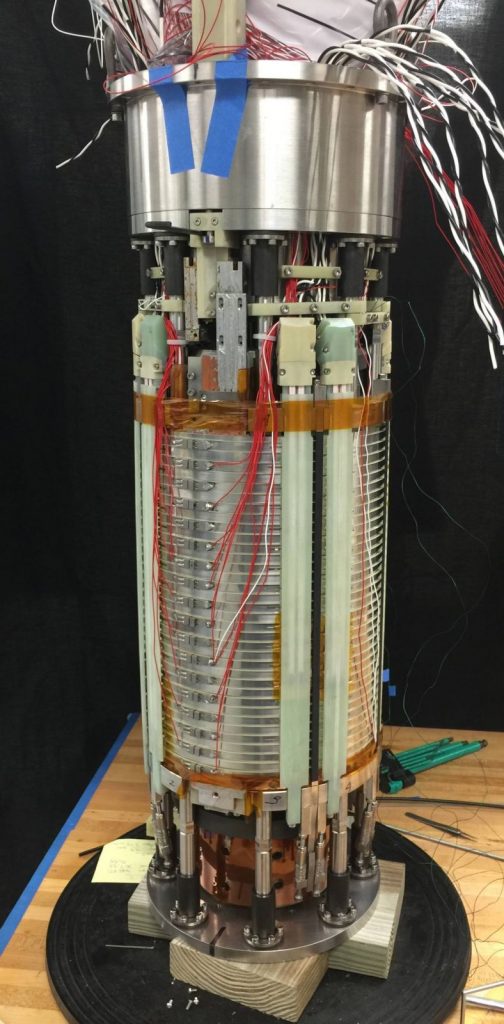National MagLab’s latest magnet snags world record, marks new era of scientific discovery
The Florida State University-headquartered National High Magnetic Field Laboratory has shattered another world record with the testing of a 32-tesla magnet — 33 percent stronger than what had previously been the world’s strongest superconducting magnet used for research and more than 3,000 times stronger than a small refrigerator magnet.
On Dec. 8, this new magnet reached a magnetic field of 32 tesla. Tesla is a unit of magnetic field strength; a small refrigerator magnet is about .01 tesla.
Made of a combination of conventional low-temperature and novel high-temperature superconductors, the “32 T” will allow physicists studying materials to explore how electrons interact with each other and their atomic environment, enabling new devices that will shape our world.

For decades, the world record for a superconducting magnet has inched forward incrementally. This single leap is bigger than all the improvements made over the past 40 years combined.
“This is a transformational step in magnet technology, a true revolution in the making,” said MagLab Director Greg Boebinger. “Not only will this state-of-the-art magnet design allow us to offer new experimental techniques here at the lab, but it will boost the power of other scientific tools such as X-rays and neutron scattering around the world.”
It has been a remarkable year for the MagLab, noted Boebinger: The 32 T is the third world-record magnet tested in the past 13 months, following a 41.4-tesla resistive magnet tested last summer and the 36-tesla Series Connected Hybrid magnet that reached full field in November 2016.
“We’re on a roll,” Boebinger said.
The new magnet represents a milestone in high-temperature superconductivity, a phenomenon that made a tremendous stir in the science community when it was first discovered 31 years ago.
Superconductors are materials that conduct electricity with perfect efficiency (unlike copper, in which electrons encounter a lot of friction). So-called low-temperature superconductors, discovered a century ago, work only in extremely cold environments and generally stop working inside magnetic fields higher than about 25 tesla. That constraint has limited the strength of superconducting magnets.
But in 1986 scientists discovered the first high-temperature superconductors, which not only work at warmer temperatures but — more importantly for magnet designers and scientists — also keep working in very high magnetic fields.
Three decades later, the new 32-tesla magnet is one of the first major applications to come out of that Nobel Prize-winning discovery.
The 32-tesla field strength is created with a combination of a conventional, or low-temperature, superconducting magnets made by industry partner Oxford Instruments and a high-temperature superconducting material called YBCO, composed of yttrium, barium, copper and oxygen. Partnering with SuperPower Inc., MagLab scientists and engineers worked for years to shape the tricky material into a reliable magnet. As part of that process, they developed new techniques for insulating, reinforcing and de-energizing the system.
For all its record-breaking impact, the 32 T is just the beginning, said MagLab scientist Huub Weijers, who oversaw its construction.
“We’ve opened up an enormous new realm,” Weijers said. “I don’t know what that limit is, but it’s beyond 100 tesla. The required materials exist. It’s just technology and dollars that are between us and 100 tesla.”
As a superconducting magnet, the 32 T features a very stable, homogenous field suitable for sensitive experiments. Combining strength and stability, it offers researchers the best of both worlds.
“The new system, and the magnets that will follow, will give scientists access to insights never before possible,” said physicist Laura Greene, the MagLab’s chief scientist. “We expect it to break new ground in a variety of research areas. Physicists are especially excited about advances in quantum matter, which features new and technologically important ultra-thin materials, as well as exotic new states of matter in topological materials and complex magnetic materials.”
The new instrument is expected to be available for use by visiting scientists next year. As with all magnets at the lab, scientists from across the world can apply to use it to explore new physics, chemistry and biology related to materials, health and energy.
No comments:
Post a Comment